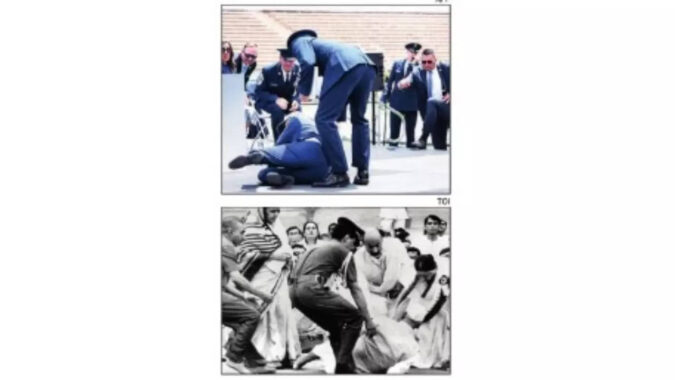NEW DELHI: Joe Biden fell – and made headlines around the world. When the powerful take a stumble, should it be news, and if it is, does it mean journalists and news consumers have poor taste? The answer s are ‘no’ and ‘no’. If public appearances of people who occupy powerful positions are news, everything about those moments being captured by cameras is news.
When a leader takes long, confident strides, when he/she jauntily climbs steps, waves, smiles and shakes hands, they and their image managers want those images to convey something. News doesn’t ignore those images just because leaders and their image managers feel good about them. So, why should news not reproduce images that show a leader stumbling, or missing a step? That these make for unflattering photographs is no argument. It’s still news. That’s why, over the years, images of wobbly leaders have made headlines.
The list includes Biden’s predecessor – and possible challenger in 2024 – Donald Trump, Gerald Ford, another American president, Hillary Clinton, who twice failed to get the top job, China’s Xi Jinping, Russia’s Vladimir Putin, Britain’s Margaret Thatcher and Boris Johnson, and Zimbabwe’s Robert Mugabe. We should a dd India’s 9th president S hankar Dayal Sharma to the list.
Sure, some have laughed at these images, comics have made jokes out of them – Xi’s stumble was called the Great Fall of China – and, in democracies, the opposition often seeks to score points when the leader in power takes a tumble. But none of that’s a matter of poor taste o n the part of news or its consumers. We are interested in the powerful, but mostly we see highly curated, managed images of them. A photograph of a leader stumbling, in contrast, seems more real. It makes him/ her seem more like us. It’s a glimpse into the person hidden inside the carefully crafted personality. It’s, simply put, interesting. And news is not just about what’s important, it ’s also about – perhaps even more about -what’s interesting. If two men who have been unsteady on their feet in public battle it out in America’s next presidential elections, it will be news that’s interesting in all kinds of ways.
When a leader takes long, confident strides, when he/she jauntily climbs steps, waves, smiles and shakes hands, they and their image managers want those images to convey something. News doesn’t ignore those images just because leaders and their image managers feel good about them. So, why should news not reproduce images that show a leader stumbling, or missing a step? That these make for unflattering photographs is no argument. It’s still news. That’s why, over the years, images of wobbly leaders have made headlines.
The list includes Biden’s predecessor – and possible challenger in 2024 – Donald Trump, Gerald Ford, another American president, Hillary Clinton, who twice failed to get the top job, China’s Xi Jinping, Russia’s Vladimir Putin, Britain’s Margaret Thatcher and Boris Johnson, and Zimbabwe’s Robert Mugabe. We should a dd India’s 9th president S hankar Dayal Sharma to the list.
Sure, some have laughed at these images, comics have made jokes out of them – Xi’s stumble was called the Great Fall of China – and, in democracies, the opposition often seeks to score points when the leader in power takes a tumble. But none of that’s a matter of poor taste o n the part of news or its consumers. We are interested in the powerful, but mostly we see highly curated, managed images of them. A photograph of a leader stumbling, in contrast, seems more real. It makes him/ her seem more like us. It’s a glimpse into the person hidden inside the carefully crafted personality. It’s, simply put, interesting. And news is not just about what’s important, it ’s also about – perhaps even more about -what’s interesting. If two men who have been unsteady on their feet in public battle it out in America’s next presidential elections, it will be news that’s interesting in all kinds of ways.
